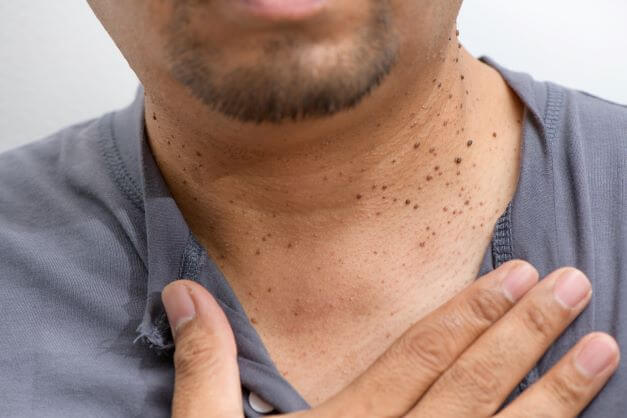Skin tags are common growths that develop on the surface of the skin. In most cases, people who develop one skin tag are significantly more likely to develop multiple skin tags. While they’re not typically harmful, they can have an unwanted appearance or be uncomfortable and irritating. According to Dr. Stephen Matlock of U.S. Dermatology Partners in Joplin, Missouri, “The main problem with skin tags is usually the locations where they develop. While these skin growths don’t necessarily present a danger to your skin health or overall well-being, they can be uncomfortable and unwanted. If you’re dealing with one skin tag or you have a chronic issue with skin tags, a dermatologist can help you address these issues to keep your skin looking and feeling its best.” If you’re interested in learning more about just what skin tags are, what causes them, and how to treat them, keep reading or reach out to Dr. Matlock and the U.S. Dermatology Partners team near you to learn more.
What Exactly Is a Skin Tag?
Skin tags are small growths that protrude from the surface of the skin. They are usually small, thin, cylindrical-shaped protrusions of skin that match natural skin tone or may be a shade or two darker. Usually very small, about the size of a grain of rice or pebble, they can grow larger if not removed. Individuals may develop single or multiple skin tags. These soft tags of skin are malleable, meaning they can be moved around easily without giving much resistance or causing any discomfort.
Skin tags most often develop in areas where there is excess skin that folds or sags, causing friction as the skin rubs together. Skin tags may also develop in areas that receive repeated friction against the skin. For instance, people may develop skin tags along the neck or chest where seatbelts or bag straps rub against the skin. While skin tags are completely benign, they may be irritating, and can get caught in jewelry or clothing causing discomfort or bleeding.
Skin tags are sometimes mischaracterized as other common skin conditions, including moles and warts. While these growths may look similar, some important differences set skin tags apart from moles and warts. The most significant difference is that moles and warts can both be warning signs of more serious health issues, but skin tags are almost always completely benign. Moles are usually a different color than the rest of the skin. In most cases, moles are darker in color, but they may also be red, pink, or brown. Some moles are slightly raised from the skin, but for the most part, they are flat. In many cases, moles are harmless, but new or changing moles can be an early warning sign of skin cancer, specifically melanoma skin cancer. Warts are skin growths that are caused by the human papillomavirus. They may look more like skin tags as both types of lesions are usually similar in tone to the skin. However, unlike soft, malleable skin tags, warts are often rough in texture, and they are typically firm and unmovable.
What Causes Them?
When it comes to cause, Dr. Matlock says “Skin tags aren’t necessarily tied to one specific underlying cause. Instead, several factors increase one’s risk of developing skin tags. These risk factors include excess weight, sagging skin or skin folds, repeated rubbing or friction against one area of skin, poorly managed diabetes, and genetics. Additionally, older adults are significantly more likely to develop skin tags than younger people. For the most part, these underlying causes can’t really be changed, but understanding you’re at greater risk can make it easier to plan for the management and treatment of skin tags.”
Are They Preventable?
According to Dr. Matlock, “There’s not necessarily a specific way to prevent skin tags, but you can make lifestyle adjustments to reduce your risk of developing skin tags. Specifically, skin tags are more common within folds of skin, so addressing skin folds by removing sagging or excess skin or losing weight if skin folds are caused by fat stores can help prevent the development of skin tags. Additionally, poorly managed diabetes can lead to skin tags, so taking steps to address diabetes symptoms and keep insulin levels stable can reduce the risk of skin tags. Finally, avoiding friction, especially repetitive friction, is a great way to reduce your risk of skin tag development.”
How Do You Remove Skin Tags?
If your skin tag needs to be removed due to an uncomfortable location, itching, irritation, bleeding, or cosmetic concern, a dermatologist will always be happy to help. Some of the common options for removing skin tags include:
- Cryotherapy – Using liquid nitrogen to create extreme cold that freezes the skin tag, which kills the skin cells, so the skin tag can be removed.
- Curettage and cautery – Using heat to destroy the skin tag and cauterize the wound to prevent bleeding and promote healing.
- Laser therapy – Using laser light to destroy the skin tag. Then, the skin tag is easily removed.
- Surgical excision – Using a scalpel to remove the skin tag and closing any open wound with a suture.
Many at-home treatments purport to be effective in removing skin tags. But, because these products can be damaging to healthy skin, it’s important to ask your dermatologist for guidance before attempting any at-home treatments.
Want to Work with a Dermatologist?
If you are concerned about removing skin tags, please don’t hesitate to reach out to us at a U.S. Dermatology Partners location near your home or office. Our knowledgeable professionals are dedicated to providing exceptional care to help you maintain healthy, beautiful skin. Simply take a few minutes to complete our scheduling request form. Once we hear from you, we’ll be in touch to finalize the details of your appointment. In addition to providing numerous treatment options for skin tags, U.S. Dermatology Partners also offers annual skin exams, support in choosing the right skincare products, and more advanced medical and cosmetic dermatologic treatments. Our dermatologists and trusted staff members are here to support all of your skin health needs.
Find a location near me
or


